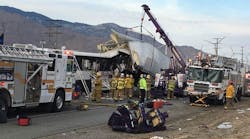A deadly 2016 California crash between a passenger bus and tractor-trailer that left 13 dead is being blamed on driver fatigue and “inadequate” traffic management in and around a highway work zone.
According to an abstract of a soon-to-be released final report by the National Transportation Safety Board (NTSB), the primary cause of the fatal early-morning crash on Interstate 10 outside Palm Springs, CA, in October last year was an “inadequate transportation management plan” put in place by the California Department of Transportation (Caltrans) for stopping highway traffic near utility work, coupled with driver fatigue on the part of both the bus and tractor-trailer operators.
NTSB said the passenger bus, traveling at highway speed, slammed into the rear of a tractor-trailer that had been stopped, along with other traffic, by police for “utility work.”
NTSB placed some of the blame for the crash on both the tractor-trailer and bus drivers, citing fatigue as the culprit.
That’s because the tractor-trailer remained stopped despite the resumption of traffic flow for a full two minutes – whereupon the passenger bus, which did not slow down despite the stopped traffic ahead, crashed into it, killing the bus driver and 12 passengers.
The crash was so violent that the bus “intruded” about 13 ft. into the truck’s trailer and pushed it 71 ft. forward, the agency reported.
The NTSB determined the probable cause of the crash was an “inadequate transportation management plan” for stopping traffic on the part of Caltrans, which resulted in a hazardous situation in which law enforcement did not detect the tractor-trailer’s lack of movement following the traffic break and did not provide any advance warning to the bus driver of the potential for stopped traffic ahead.
The board also determined the truck driver did not resume driving after the traffic stoppage because he most likely fell asleep due to fatigue related to his undiagnosed, moderate-to-severe obstructive sleep apnea. Despite the fact the truck driver was severely obese and at a very high risk for obstructive sleep apnea, he had not been tested for the condition. And although the Federal Motor Carrier Safety Administration (FMCSA) has developed guidance for screening for obstructive sleep apnea, it hasn’t “disseminated” this guidance to the medical examiners it certifies to perform commercial driver’s license medical examinations, NTSB said.
The investigation also revealed the bus driver had untreated diabetes, but the FMCSA-certified medical examiner did not diagnose the bus driver’s condition or refer the driver for further testing despite a positive glucose urine test during the driver’s medical certificate examination. The NTSB also found that the bus driver did not take actions to avoid the crash because he too was likely fatigued and did not expect to encounter stopped traffic.
“In this crash, not one but two commercial vehicle drivers – people who drive for a living – were unable to respond appropriately to cues that other motorists acted on,’’ noted NTSB Chairman Robert Sumwalt, in a statement. “Federal and state regulators, commercial motor carriers and professional drivers can do better. Given the stakes, they must do better.’’
The board issued eight safety recommendations based upon the findings of the investigation, making two recommendations to the FMCSA, three to the Federal Highway Administration (FHWA), one to the trucking company, one to three national trucking associations and one to the International Association of Chiefs of Police and the National Sheriffs’ Association.



